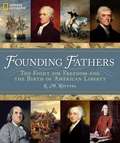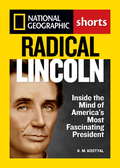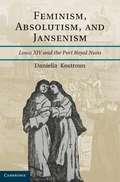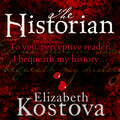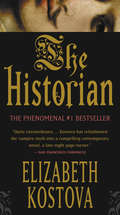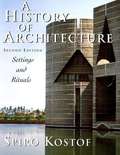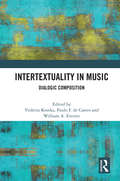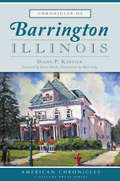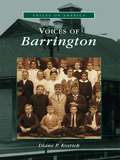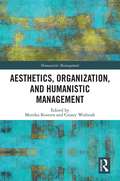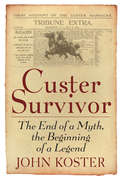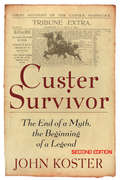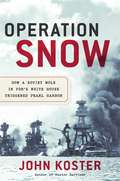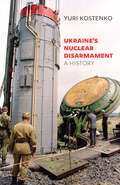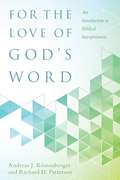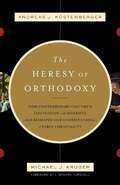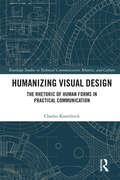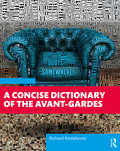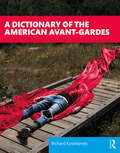- Table View
- List View
Founding Fathers: The Fight for Freedom and the Birth of American Liberty
by K. M. Kostyal Jack N. RakoveKostyal tells the story of the great American heroes who created the Declaration of Independence, fought the American Revolution, shaped the US Constitution--and changed the world. The era's dramatic events, from the riotous streets in Boston to the unlikely victory at Saratoga, are punctuated with lavishly illustrated biographies of the key founders--Alexander Hamilton, John Adams, Ben Franklin, Thomas Paine, Thomas Jefferson, George Washington, and James Madison--who shaped the very idea of America. An introduction and ten expertly-rendered National Geographic maps round out this ideal gift for history buff and student alike. Filled with beautiful illustrations, maps, and inspired accounts from the men and women who made America, Founding Fathers brings the birth of the new nation to light.
Radical Lincoln: Inside the Mind of America's Most Fascinating President
by K. M. KostyalHe has more books written about him than any other President of the United States but what do we really know about the man himself? There are a handful of facts: he was from the frontier, was raised in a poor farmer family, had a passion for learning, was quiet, and a skeptic. Millions of words have been spilled over the details of his life. But who was the real Lincoln? In this daring ebook short, K. M. Kostyal uses the facts of Lincoln's early life to build a psychological profile of the man who would change the course of history. She examines his early life to understand how this bright frontier lawyer would come to lead a nation, noting especially the dramatic influence of Lincoln's hard-driving father and his brilliant, political, and often misunderstood wife Mary in challenging him to reach for the highest office in the United States. She further looks at just how such a brilliant political mind was able to maintain his connection to simple country folk, and how that connection has amplified over the decades so that the 'cult of Lincoln' that only grows larger with each passing year. Bringing fresh insights and a brilliant grasp of history to one of history's most enigmatic characters, Kostyal paints a compulsively readable portrait that will be a popular read for years to come.
Radical Lincoln
by K. M. KostyalLincoln, the 16th President of the United States, held a nation together during a brutal Civil War and changed the course of history by ending slavery. He has more books written about him than any other President of the United States but what do we really know about the "man" himself? There are a handful of facts: he was from the frontier, was raised in a poor farmer family, had a passion for learning, was quiet, and a skeptic. Millions of words have been spilled over the details of his life. But who was the real Lincoln? In this daring ebook short, K.M. Kostyal uses the facts of Lincoln's early life to build a psychological profile of the man who would change the course of history. She examines his early life to understand how this bright frontier lawyer would come to lead a nation, noting especially the dramatic influence of Lincoln's hard-driving father and his brilliant, political, and often misunderstood wife Mary in challenging him to reach for the highest office in the United States. She further looks at just how such a brilliant political mind was able to maintain his connection to simple country folk, and how that connection has amplified over the decades so that the 'cult of Lincoln' that only grows larger with each passing year. Bringing fresh insights and a brilliant grasp of history to one of history's most enigmatic characters, Kostyal paints a compulsively readable portrait that will be a popular read for years to come.
Feminism, Absolutism, and Jansenism
by Daniella KostrounFeminism, Absolutism, and Jansenism chronicles seventy years of Jansenist conflict and its complex intersection with power struggles between gallican bishops, Parlementaires, the Crown and the Pope. Daniella Kostroun focuses on the nuns of Port-Royal-des-Champs, whose community was disbanded by Louis XIV in 1709 as a threat to the state. Paradoxically, it was the nuns' adherence to their strict religious rule and the ideal of pious, innocent and politically disinterested behavior that allowed them to challenge absolutism effectively. Adopting methods from cultural studies, feminism and the Cambridge School of political thought, Kostroun examines how these nuns placed gender at the heart of the Jansenist challenge to the patriarchal and religious foundations of absolutism; they responded to royal persecution with a feminist defense of women's spiritual and rational equality and of the autonomy of the individual subject, thereby offering a bold challenge to the patriarchal and religious foundations of absolutism.
The Historian
by Elizabeth KostovaIn this internationally bestselling novel, the author of The Swan Thieves has 'refashioned the vampire myth into a compelling...late-night page-turner' - San Francisco ChronicleLate one night, exploring her father's library, a young woman finds an ancient book and a cache of yellowing letters addressed ominously to 'My dear and unfortunate successor'. Her discovery plunges her into a world she never dreamed of - a labyrinth where the secrets of her father's past and her mother's mysterious fate connect to an evil hidden in the depths of history. In those few quiet moments, she unwittingly assumes a quest she will discover is her birthright - a hunt for the truth about Vlad the Impaler, the medieval ruler whose barbarous reign formed the basis of the Dracula myth. Deciphering obscure signs and hidden texts, reading codes worked into the fabric of medieval monastic traditions, and evading terrifying adversaries, one woman comes ever closer to the secret of her own past and a confrontation with the very definition of evil. Elizabeth Kostova's debut novel is an adventure of monumental proportions - a captivating tale that blends fact and fantasy, history and the present with an assurance that is almost unbearably suspenseful - and utterly unforgettable.'Quite extraordinary....Kostova is a natural storyteller....She has refashioned the vampire myth into a compelling contemporary novel, a late-night page-turner' - San Francisco Chronicle'Filled with fascinating details of archaic vampire lore, the splendours of the Ottoman Empire and the beauty of the Romanian countryside' - Times Literary Supplement
The Historian: The captivating international bestseller and Richard and Judy Book Club pick
by Elizabeth KostovaIn this internationally bestselling novel, the author of The Swan Thieves has 'refashioned the vampire myth into a compelling...late-night page-turner' - San Francisco ChronicleLate one night, exploring her father's library, a young woman finds an ancient book and a cache of yellowing letters addressed ominously to 'My dear and unfortunate successor'. Her discovery plunges her into a world she never dreamed of - a labyrinth where the secrets of her father's past and her mother's mysterious fate connect to an evil hidden in the depths of history. In those few quiet moments, she unwittingly assumes a quest she will discover is her birthright - a hunt for the truth about Vlad the Impaler, the medieval ruler whose barbarous reign formed the basis of the Dracula myth. Deciphering obscure signs and hidden texts, reading codes worked into the fabric of medieval monastic traditions, and evading terrifying adversaries, one woman comes ever closer to the secret of her own past and a confrontation with the very definition of evil. Elizabeth Kostova's debut novel is an adventure of monumental proportions - a captivating tale that blends fact and fantasy, history and the present with an assurance that is almost unbearably suspenseful - and utterly unforgettable.'Quite extraordinary....Kostova is a natural storyteller....She has refashioned the vampire myth into a compelling contemporary novel, a late-night page-turner' - San Francisco Chronicle'Filled with fascinating details of archaic vampire lore, the splendours of the Ottoman Empire and the beauty of the Romanian countryside' - Times Literary Supplement
The Historian: To You, Perceptive Reader, I Bequeath My History
by Elizabeth KostovaTo you, perceptive reader, I bequeath my history... Late one night, exploring her father's library, a young woman finds an ancient book and a cache of yellowing letters. The letters are all addressed to My dear and unfortunate successor, and they plunge her into a world she never dreamed of a labyrinth where the secrets of her father's past and her mother's mysterious fate connect to an inconceivable evil hidden in the depths of history. The letters provide links to one of the darkest powers that humanity has ever known and to a centuries-long quest to find the source of that darkness and wipe it out. It is a quest for the truth about Vlad the Impaler, the medieval ruler whose barbarous reign formed the basis of the legend of Dracula. Generations of historians have risked their reputations, their sanity, and even their lives to learn the truth about Vlad the Impaler and Dracula. Now one young woman must decide whether to take up this quest herself to follow her father in a hunt that nearly brought him to ruin years ago, when he was a vibrant young scholar and her mother was still alive. What does the legend of Vlad the Impaler have to do with the modern world? Is it possible that the Dracula of myth truly existed and that he has lived on, century after century, pursuing his own unknowable ends? The answers to these questions cross time and borders, as first the father and then the daughter search for clues, from dusty Ivy League libraries to Istanbul, Budapest, and the depths of Eastern Europe. In city after city, in monasteries and archives, in letters and in secret conversations, the horrible truth emerges about Vlad the Impaler's dark reign and about a time-defying pact that may have kept his awful work alive down through the ages. Parsing obscure signs and hidden texts, reading codes worked into the fabric of medieval monastic traditions and evading the unknown adversaries who will go to any lengths to conceal and protect Vlad's ancient powers one woman comes ever closer to the secret of her own past and a confrontation with the very definition of evil. Elizabeth Kostova's debut novel is an adventure of monumental proportions, a relentless tale that blends fact and fantasy, history and the present, with an assurance that is almost unbearably suspenseful and utterly unforgettable.
A History of Architecture: Settings and Rituals
by Spiro Kostof Gregory CastilloWhen the late Spiro Kostof's A History of Architecture appeared in 1985, it was hailed as a masterpiece--one of the finest books on architecture. The New York Times Book Review, called it "a magnificent guided tour through mankind's architecture."
Intertextuality in Music: Dialogic Composition
by Violetta KostkaThe concept of intertextuality – namely, the meaning generated by interrelations between different texts – was coined in the 1960s among literary theorists and has been widely applied since then to many other disciplines, including music. Intertextuality in Music: Dialogic Composition provides a systematic investigation of musical intertextuality not only as a general principle of musical creativity but also as a diverse set of devices and techniques that have been consciously developed and applied by many composers in the pursuit of various artistic and aesthetic goals. Intertextual techniques, as this collection reveals, have borne a wide range of results, such as parody, paraphrase, collage and dialogues with and between the past and present. In the age of sampling and remix culture, the very notion of intertextuality seems to have gained increased momentum and visibility, even though the principle of creating new music on the basis of pre-existing music has a long history both inside and outside the Western tradition. The book provides a general survey of musical intertextuality, with a special focus on music from the second half of the twentieth century, but also including examples ranging from the nineteenth century to the second decade of the twenty-first century. The volume is intended to inspire and stimulate new work in intertextual studies in music.
Chronicles of Barrington, Illinois (American Chronicles)
by Diane P. Kostick Karen Darch Mort LubyNestled in the northwestern suburbs of Chicago, Barrington offers a treasure-trove of fascinating history and area lore. Meet the passionate guardians of this bucolic landscape who embody the pioneering midwestern spirit. While the community maintains a proud tradition of civic improvement and conservation, its citizens ably represent Barrington in the national arena. The town's record of military service and veteran care dates back to the Civil War. Floyd Bateman helped organize the 1933 World's Fair, while Christine O'Malley won acclaim at the Sundance Film Festival for her crossword documentary. Three members of the 1985 Bears championship squad called the enclave home. Author Diane Kostick paints a portrait of those whose vision, resourcefulness and dedication contributed to the strength and character of this proud community.
Voices of Barrington (Voices of America)
by Diane P. KostickOriginally settled by Irish, German, and English pioneers, the Barrington area has a long history of industrious and courageous citizens. In the early 1800s, these settlers laid the foundation for the Barrington of today: a colorful community beloved by residents and visitors. In a tribute to this town's heritage, Voices of Barrington profiles the people who have made-and who continue to make-Barrington a place rich with character and small-town charm. In this collection, the men and women who recount stories of times past and present offer a behind-the-scenes look at how they overcame obstacles and helped to shape their community. Readers discover that the barber down the street also struggled through the Great Depression, and that the brew-pub owner moved entire buildings in order to establish his business. Historic photographs from the Barrington Fire Department, library, daily newspaper, and the contributors' own family collections highlight the stories. The result is an intimate portrait of a typical-and extraordinary-American town.
The Crusades and the Near East: Cultural Histories
by Conor KostickThe crusades are often seen as epitomising a period when hostility between Christian West and the Muslim Near East reached an all time high. As this edited volume reveals, however, the era was one which saw both conflict and cohabitation. Tackling such questions as whether medicinal and architectural innovations came to Europe as a direct result of the Crusades, and why and how peace treaties and intermarriages were formed between the different cultures, this distinguished group of contributors reveal how the Holy Wars led on the one hand to a reinforcement of the beliefs and identities of each side, but on the other to a growing level of cultural exchange and interaction. This volume breaks new ground in not only exploring the conflict between the Christian and the Muslim worlds, but also the impact of this conflict on the cultural evolution of European and Near Eastern thought and practices. Utilising the latest scholarship and original studies of the sources, this survey sheds new light on the cultural realities of East-West relations and marks a new departure for studies of the crusades. Contributors include John France, Yehoshua Frenkel, Chris Wright, Natasha Hodgson, A.V. Murray, Sini Kangas, Léan Ní Chléirigh, Susan Edgington, Jürgen Krüger, Yvonne Friedman and Bernard Hamilton.
Aesthetics, Organization, and Humanistic Management (Humanistic Management)
by Monika KosteraThis book is a reaction to the reductionist and exploitative ideas dominating the mainstream contemporary management discourse and practice, and an attempt to broaden the horizons of possibility for both managers and organization scholars. It brings together the scholarly fields of humanistic management and organizational aesthetics, where the former brings in the unshakeable focus on the human condition and concern for dignity, emancipation, and the common good, while the latter promotes reflection, openness, and appreciation for irreducible complexity of existence. It is a journey towards wholeness undertaken by a collective of management and organization theorists, philosophers, artists, and art curators. Reading this book’s contributions can help both academics and practitioners work towards building organizational practices aimed at (re)acquiring wholeness by developing aesthetic awareness allowing for more profound understandings of performativity, insights into the dynamics of power, appreciation of ambiguity and ambivalence, and a much needed grasp of complexity. The varied ways of engaging with art explored by the authors promote imaginative insights into and reflection on the beauty and vicissitudes of organizing, of management knowledge and collective expression. It will be of interest to researchers, academics, practitioners, and students in the fields of organizational theory and practice, business and management history, human resource management, and culture management.
In the Time of the Tyrants: Panama, 1968-1990
by Richard M. Koster Guillermo Sanchez BorbonAn eyewitness account of how Panama, since 1968, has fallen victim to a line of military dictators who have fattened on the misery of a country once democratic and prosperous. The authors, an American novelist and a Panamanian journalist, were actors in the drama of Panama as well as observers. They tell the story of how the darkness fell on Panama, how the tyrants, from Omar Torrijos to Manuel Noriega, became creatures of the secret government of the United States, and were supported long after their true nature was known. It is the story of those tyrants killed, those they corrupted and those who were brave enough to stand up to them.
Custer Survivor: The End Of The Myth, The Beginning Of A Legend
by John KosterCuster Survivor was the basis for History Channel's television documentary Custer's Last Stand about the one man in the Seventh Cavalry who escaped the annihilation at the Battle of the Little Big Horn. It is the story of Sgt. Frank Finkel of "C" Company, who, stunned by the impact of a rifle barrel smashing his forehead, was carried off by his panic stricken horse. Drawn from Sioux observations, Dept. of Army documents and forensic evidence, this is the story of the one soldier who escaped death at Little Big Horn and the fascinating life story of the man who turned myth into legend.
Custer Survivor, Second Edition: The Final Showdown
by John KosterThis Second edition includes photographs from both the Ohio and Washington State branches of Frank Finkel's family and from the public domain which offer camera portraits of August Finckle, second sergeant of C Company, 7th Cavalry, reportedly killed at Custer's Last Stand and of purported Custer Survivor Frank Finkel and his father and mother. Research published after the original CUSTER SURVIVOR also contests the idea that any reliable witness saw Sergeant Finckle's body at the Little Bighorn.It has been recorded in official government records that there were no survivors of the five companies of the Seventh Cavalry who were with General George Armstrong Custer at the battle at the Little Big Horn. Recently, uncovered records and forensic handwriting evidence, the latter verified by forensic handwriting experts, reveal that one trooper, a sergeant in C Company of the Seventh Cavalry, actually escaped the onslaught of Sioux and Cheyenne. The author has tracked the man and his activity during the battle and has brought them together in Custer Survivor.Custer Survivor, through documented accounts recreates the scene from the Sioux and Cheyenne encampment the night before the battle through the action the following day, the remarkable escape of the wounded survivor, the aftermath of the battle and his fascinating life thereafter. Professor Louise Barnett, a fellow of the Rutgers Center for Historical Analysis, Rutgers University, writes the Introduction.
Operation Snow: How a Soviet Mole in FDR's White House Triggered Pearl Harbor (World War Ii Collection)
by John KosterIn Operation Snow: How a Soviet Mole in FDR's White House Triggered Pearl Harbor, author and World War II magazine columnist John Koster provides incontestable proof that Russia was a driving force behind Pearl Harbor. Koster reveals how Stalin and the KGB used a network of double agents and communist sympathizers at the highest levels in Washington to push Japan into war against America.
Ukraine’s Nuclear Disarmament: A History (Harvard Series in Ukrainian Studies; #78)
by Yuri KostenkoIn December 1994 Ukraine gave up the third-largest nuclear arsenal in the world and signed the Non-Proliferation Treaty, having received assurances that its sovereignty would be respected and secured by Russia, the United States, and the United Kingdom. Based on original and heretofore unavailable documents, Yuri Kostenko’s account of the negotiations between Ukraine, Russia, and the US, reveals for the first time the internal debates of the Ukrainian government, as well as the pressure exerted upon it by its international partners. Kostenko presents an insider’s view on the issue of nuclear disarmament and raises the question of whether the complete and immediate dismantlement of the country’s enormous nuclear arsenal was strategically the right decision, especially in view of the 2014 annexation of Crimea by Russia, one of the guarantors of Ukraine’s sovereignty under denuclearization.
Ukraine’s Nuclear Disarmament: A History (Harvard Series in Ukrainian Studies; #78)
by Yuri KostenkoIn December 1994, Ukraine gave up the third-largest nuclear arsenal in the world and signed the Non-Proliferation Treaty, having received assurances that its sovereignty would be respected and secured by Russia, the United States, and the United Kingdom. Based on original and heretofore unavailable documents, Yuri Kostenko’s account of the negotiations between Ukraine, Russia, and the US reveals for the first time the internal debates of the Ukrainian government as well as the pressure exerted upon it by its international partners.Kostenko presents an insider’s view on the issue of nuclear disarmament and raises the question of whether the complete and immediate dismantlement of the country’s enormous nuclear arsenal was strategically the right decision, especially in view of the 2014 annexation of Crimea by Russia, one of the guarantors of Ukraine’s sovereignty under denuclearization.
For the Love of God's Word: An Introduction to Biblical Interpretation
by Andreas J. Köstenberger Richard D. PattersonAn introduction to a clear method of biblical interpretation For the Love of God's Word is an abridged, less technical version of Kostenberger and Patterson's acclaimed Invitation to Biblical Interpretation. Students, teachers, and pastors alike will find this introduction to biblical hermeneutics to be an accessible resource with both breadth and substance. Built on the premise that every passage requires careful scrutiny of its historical setting, literary dimension, and theological message, this volume teaches a simple threefold method that is applicable to every passage of Scripture regardless of genre. In addition, the book sets forth specific strategies for interpreting the various genres of Scripture, from poetry to epistle to prophecy. A final chapter is devoted to helpful Bible study resources that will equip the reader to apply Scripture to life. This book will serve as a standard text for interpreting Scripture that is both academically responsible and accessible for pastors, teachers, and college students. This volume will enable students of Scripture to grow in love for God's Word as they grow in the disciplines of study and discernment.
The Heresy of Orthodoxy: How Contemporary Culture's Fascination With Diversity Has Reshaped Our Understanding of Early Christianity
by Andreas J. Köstenberger Michael J. Kruger I. Howard MarshallBeginning with Walter Bauer in 1934, the denial of clear orthodoxy in early Christianity has shaped and largely defined modern New Testament criticism, recently given new life through the work of spokesmen like Bart Ehrman. Spreading from academia into mainstream media, the suggestion that diversity of doctrine in the early church led to many competing orthodoxies is indicative of today's postmodern relativism. Authors Köstenberger and Kruger engage Ehrman and others in this polemic against a dogged adherence to popular ideals of diversity. <p><p> Köstenberger and Kruger's accessible and careful scholarship not only counters the "Bauer Thesis" using its own terms, but also engages overlooked evidence from the New Testament. Their conclusions are drawn from analysis of the evidence of unity in the New Testament, the formation and closing of the canon, and the methodology and integrity of the recording and distribution of religious texts within the early church.
Humanizing Visual Design: The Rhetoric of Human Forms in Practical Communication (Routledge Studies in Technical Communication, Rhetoric, and Culture)
by Charles KostelnickThis book analyzes the role that human forms play in visualizing practical information and in making that information understandable, accessible, inviting, and meaningful to readers—in short, "humanizing" it.Although human figures have long been deployed in practical communication, their uses in this context have received little systematic analysis. Drawing on rhetorical theory, art history, design studies, and historical and contemporary examples, the book explores the many rhetorical purposes that human forms play in functional pictures, including empowering readers, narrating processes, invoking social and cultural identities, fostering pathos appeals, and visualizing data.The book is aimed at scholars, teachers, and practitioners in business, technical, and professional communication as well as an interdisciplinary audience in rhetoric, art and design, journalism, engineering, marketing, science, and history.
A Concise Dictionary of the Avant-Gardes: Concise Edition
by Richard KostelanetzFor a concise edition of his legendary arts dictionary of information and opinion, the distinguished critic and arts historian Richard Kostelanetz selects entries from the 2018 third edition. Typically he provides intelligence unavailable anywhere else, no less in print than online, about a wealth of subjects and individuals. Focused upon what is truly innovative and excellent, Kostelanetz also ranges widely with insight and surprise, including appreciations of artistic athletes such as Muhammad Ali and the Harlem Globetrotters and such collective creations as Las Vegas and his native New York City. Continuing the traditions of cheeky high-style Dictionarysts, honoring Ambrose Bierce and Samuel Johnson (both with individual entries), Kostelanetz offers a "reference book" to be enjoyed, not only in bits and chunks but continuously as one of the ten books someone would take if he or she planned to be stranded on a desert isle.
A Dictionary of the American Avant-Gardes
by Richard KostelanetzFor this American edition of his legendary arts dictionary of information and opinion, the distinguished critic and arts historian Richard Kostelanetz has selected from the fuller third edition his entries on North Americans, including Canadians, Mexicans, and resident immigrants. Typically, he provides intelligence unavailable anywhere else, no less in print than online, about a wealth of subjects and individuals. Focused upon what is truly innovative and excellent, Kostelanetz also ranges widely with insight and surprise, including appreciations of artistic athletes such as Muhammad Ali and the Harlem Globetrotters, and such collective creations as Las Vegas and his native New York City. Continuing the traditions of cheeky high-style Dictionarysts, honoring Ambrose Bierce and Nicolas Slonimsky (both with individual entries), Kostelanetz offers a "reference book" to be treasured not only in bits and chunks, but continuously as one of the ten books someone would take if they planned to be stranded on a desert isle.
The Frog Lake Reader
by Myrna KostashNonfiction author Myrna Kostash merges the past and the present in The Frog Lake Reader, which offers a multi-layered perspective on the tragic events surrounding the Frog Lake Massacre of 1885. By bringing together eyewitness accounts and journal excerpts, memoirs and contemporary fiction, and excerpts from interivews with historians, Kostash provides a panoramic view of a tragedy often overshadowed by Louis Riel's rebellion of the same year. The history is contentious and its interpretation unresolved, but The Frog Lake Reader, with its broad survey of vital historical accounts and points of view, offers the most comprehensive and informative narrative on the Frog Lake Massacre to date.
